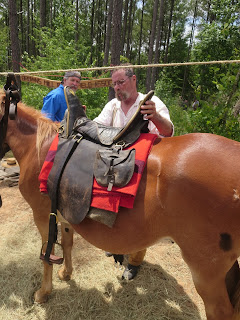Over the seven years I’ve authored this blog, I’ve rarely delved very deep into the topics of military gear and weapons. (I don’t have the expertise, but sometimes I’ve spoken with experts.)
I traveled
this past weekend to Newnan, Ga., for the 152nd anniversary of the
Battle of Brown’s Mill. Because it was largely a cavalry battle, the Friends
group concentrated on “The Campaigner: Re-enacting the Life and Times of the
Civil War Trooper.”
I spoke with
a few participants who brought horses, mules and a 12-pound mountain howitzer
and caisson. Those who are really serious about re-enacting turn to craftsmen
and women for authentic reproductions of saddles and related gear.
Saturday’s
re-enactors described some of their saddles, and I did some subsequent online
research. Here’s what I came up with. My summaries barely scratch the surface.
 |
| Grimsley artillery driver's saddle on McClellan tree |
Thornton Grimsley of St. Louis created a saddle that was adopted in 1847 for dragoons, mounted riflemen and officers and it remained popular for two decades. “The Grimsley was a vast improvement over the Ringgold saddle, which gave poor service in the war with Mexico,” according to Border States Leatherworks. “The Grimsley tree was covered in rawhide and the seat was stuffed with deer hair under the quilted seat.” A smaller version of the Grimsley was made for U.S. artillery service during the Civil War. Gens. Ulysses Grant and William T. Sherman rode on Grimsley saddles. The Society of the Military Horse says: “The Grimsley is known to have been an excellent and expensive saddle. Its construction shows a product that used a substantial amount of leather and brass fixtures (increasing its weight and cost).”
Hope (or Texas) saddle
 |
| One of Scott Wortham's horses |
According to Glenn Pier Depot, a tack shop, the Texas-style saddle was used extensively by Southern troopers. “It was manufactured by the thousands by arsenals and civilian contractors." The Society of the Military Horse says this of the Hope saddle (named for James Hope): “This is a very specific name, associated with a particular Texas saddle maker, however the name Hope is merely one of a number of names that have been used for this style. It was much more commonly called a ‘Texas’ saddle, occasionally modified to ‘Texican.’ This Texas saddle was extremely popular and prized for its very light, strong yet inherently compromised construction. The pommel was usually made in two halves, with a wooden horn nailed to the top – covered with rawhide in the fashion of many American saddles coming from the Spanish/Mexican tradition.”
McClellan saddle
 |
| Bob McLendon of Phillips' Legion |
The U.S. Army in 1859 adopted a saddle designed by George B. McClellan after a tour of Europe. It was the most popular saddle used by Union troopers. It was affordable, lightweight and sturdy and gradually eclipsed the Grimsley. “Used throughout the world, the McClellan is one of the most popular and enduring military saddle designs ever created,” says the society.” Glenn Pier Depot said the saddle was more comfortable for less-robust horses. It was used by both sides during the Civil War, and many Rebel troopers opted to use it rather than the heavier Jenifer saddle. The McClellan supported a rawhide-covered open seat and a thick leather skirt. Some argue whether it was based on a European style or a Spanish tree saddle design. Either way, it proved to be very serviceable. It has been modified since the Civil War and the Army still uses it for ceremonial purposes.
• Related: Veterinary care during the Civil War

I'm the guy who made the bit in the black horses mouth!
ReplyDeleteThis comment has been removed by a blog administrator.
ReplyDelete